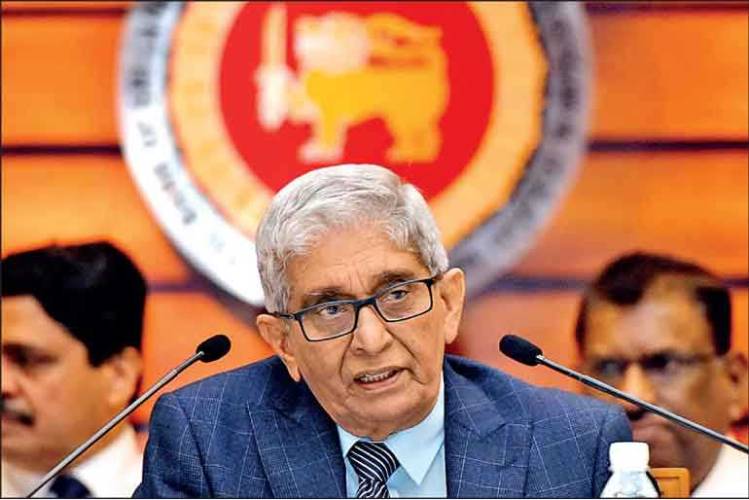Blindsided by the unexpected 1.6% contraction in the first quarter, the Central Bank yesterday declined to give fresh growth projections for the rest of the year, but said a substantial pick up is needed in the fourth quarter for Sri Lanka to end 2020 with at least 0% growth.
In the Central Bank Annual Report released earlier this year, the monetary authority predicted 1.5% or higher growth, and has stuck to the projection despite the deepening challenges posed by COVID-19.
Top Central Bank officials, including Governor Prof. W.D. Lakshman, who participated at the latest monetary policy announcement media briefing yesterday, declined to give any fresh predictions until the 2Q results are released by the Census and Statistics Department in the next few weeks, but insisted economic expansion was just round the corner.
The Governor pointed out depreciation of the rupee against the US dollar has been limited to 1.3% thus far during the year.
“We have seen the end of the Parliamentary Election, which has reconfirmed political stability that is needed to carry out the Government’s policy framework. Domestic economic activities have recovered relatively fast in spite of the contraction seen in our economic partner countries, which are still unable to distance themselves from COVID-19 related issues. We have observed greater stability in the external sector, sovereign bond yields have declined significantly, exports have rebounded and the trade deficit has improved. Excepting the last few days the exchange rate was well-behaved,” the Governor said.
However, they conceded that the contraction for the second quarter is very likely to be higher than what was seen in the first quarter. The third quarter is expected to post stronger recovery, but officials are banking on a strong end to 2020 to offset the COVID-19 impact to at least reach an even 0%.
“Our projection was 1.5% plus, but now for us to at reach least reach 0% we need a significant rebound in the fourth quarter. It is too early for us to come up with a number, but under this scenario it is more likely that we will achieve higher growth in the fourth quarter, so we will be reaching at least 0% growth under these assumptions,” Senior Deputy Governor Dr. Nandalal Weerasinghe said in response to questions.
The Central Bank, using Google mobility reports that track mobile phone movements, said there were clear indications the economy was rebounding from its COVID-19 induced slump in the second quarter, with public transport, grocery and pharmacy expenses, workplace activities and retail and recreation among other indicators reaching pre-curfew levels.
The enhanced focus on domestic production for import substitution as well as to export is expected to drive near-term growth, with potentially significant implications on the longer horizon. Sustaining the growth momentum beyond the near-term would require reforms to address structural issues in the economy.
“These all show that the economy is ready to move past the recovery stage to economic expansion,” Economic Research Department Director Dr. C. Amarasekara said.
Recapping the five policy rate reductions done since January, the Central Bank pointed out it has reduced policy interest rates by 250 basis points so far, which was on top of the 100 basis points in 2019. The Statutory Reserve Ratio (SRR) was reduced by 300 basis points on two occasions so far this year and the bank rate reduced by 650 basis points.
Improved trade balance and political stability appear to have helped stabilise the Sri Lankan rupee, Dr. Amarasekara observed. Gross official reserves were estimated at $ 7.1 billion by end July 2020, providing an import cover of 4.7 months and enough of a buffer to repay the $ 1 billion sovereign bond maturity in October. July inflation is expected to about 6% or slightly higher but the Central Bank was confident it will remain anchored, due to subdued demand despite the multiple rounds of rate relaxation.
As a result of various monetary easing measures, market interest rates are adjusting downwards, the Central Bank said, with Average Weighted Deposit Rate (AWDR) for August declining by 42 basis points to 6.74% from the previous month. AWDR has declined by 146 basis points during 2020. The Average Weighted Nominal Deposit Rate (AWNDR) declined by 142 basis points to 5.78% in July 2020 compared to the previous month. AWNDR also declined by 311 basis points during 2020. This is the lowest rates have been since September 2015.
The Average Weighted Prime Lending Rate (AWPR) has also declined significantly in recent weeks to below 7%, which is the lowest it has been since the Central Bank began collating data in 2014.
The Average Weighted Lending Rate (AWLR) declined by 35 basis points to 12.29% in July 2020 from the previous month and has seen a drop of 130 basis points during this year. However, the Central Bank acknowledged some market lending rates still remain excessive, affecting marginal borrowers in particular.
The growth of credit to the private sector is expected to recover in the period ahead, even though June growth only increased by 4.3% compared to the same period last year. Credit is expected to be driven by increased economic activity, improving business sentiment with enhanced political stability, declining market lending rates and rising credit disbursement on account of concessional credit schemes for businesses affected by the pandemic. Credit to the public sector soared in recent months reflecting the Government’s heightened funding requirement, thereby causing a notable expansion in broad money thus far in 2020, data showed.
(FT)

